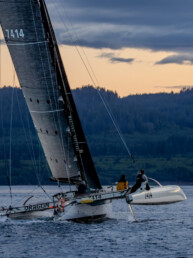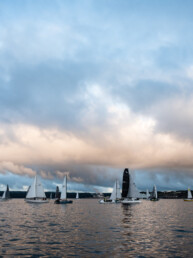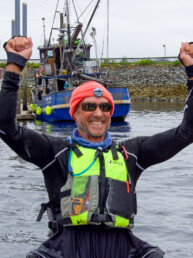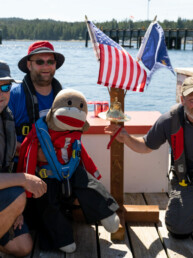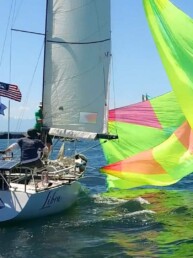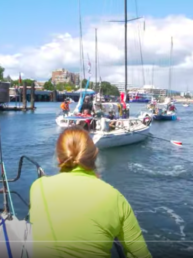
The R2AK is one way to get to Alaska, but this trek is no pleasure cruise. The rules for the Race to Alaska are simple: 750 miles to Ketchikan, navigating past two waypoints at Seymour Narrows and Bella Bella. No motor. No outside assistance. Boat for boat racing with no handicaps. The winners walk away with $10,000 cash. Second place wins a set of steak knives. For the rest, nothing but bragging rights. But that’s something in itself. Just getting there is no easy feat. The most appealing aspect of this race and what sets it apart from others is its emphasis on the pure adventure of it. Brilliantly conceived by the Northwest Maritime Center in Port Townsend four years ago, the race has garnered worldwide attention and the fleet of participants has steadily grown. It has attracted a broad spectrum of adrenaline junkies eager to conquer their own horizontal Mount Everest. This year 43 teams expressed an intent to tackle this challenging feat through a stretch of water with strong currents, heavy fog and fluctuating winds, full of built-in dangers.
Some competitors never made it to the starting line at all. Of the 39 teams who tackled the first stage across the straits from Port Townsend to Victoria, BC, only 31 felt ready to race all the way to Alaska. As of this writing, some have since dropped out—hundreds of miles into the course—due to gear breakage and other issues. And many have kept slogging their way north, long after learning they cannot possibly win because the race has already been won. They’ve carried on for the mere satisfaction of saying they’ve done it.
For Team Sail Like a Girl, just the challenge of completion inspired them to take on this epic journey. It started when Anna Stevens asked Jeanne Assael Goussev “Do you want to do R2AK with an all women crew?” The idea quickly took hold. The appeal was the combination of undertaking a worthy goal, but also of using the opportunity to show how powerful women can combine forces and do impressive things. Sail Like a Girl seemed a fitting name, since it plays on what is often hurled as an insult. The motivation was to debunk this outdated idea. They didn’t just complete the course, they beat out all others to be the first, the winners of the coveted prize.
According to Captain Jeanne Assael Goussev, doing this race had been seven months in planning and preparation. Jeanne had 20 years of racing experience and, with her family, owns Gray Wolf, a custom-built cold-molded wooden sailor that my husband Garth and I have coveted for years. She briefly considered using Gray Wolf for this effort, but soon concluded they needed a faster boat to compete against the favored multi-hulls which have dominated the races so far. She set her sights on a day-sailor, a Melges 32 — not exactly a cushy ride to Alaska.
Goussev reached out to women she knew, some sailors, some not. In fact, one woman learned to sail just to join the race. This approach set out to prove that a collaborative approach could win out over pedigree. Many more decorated sailors have tried and failed. A few early team members began raising funds by selling t-shirts on their website and their enthusiasm was contagious. When I saw Kate and Jeanne drumming up support at the Seattle Boat Show in January, I yearned to join their effort, but a previously scheduled book tour on the east coast kept me from participating this year. Ultimately Team Sail Like a Girl included four other Bainbridge Islanders, besides Captain Jeanne Assael Goussev, including Aimee Fulwell, Allison Dvaladze, Kelly Adamson Danielson and Haley King Lhamon, plus three others from Seattle: Anna Stevens, Morgan Buell and Kate Hearsey McKay, who my husband and I had raced with on T-birds. The team grew organically, though Jeanne was eager to sign on another experienced driver. That came with the addition of Haley King Lhamon as late as April.
One could ask — and many did, “What chance did they have in in a race with a history of heavy wind and sea conditions that routinely extinguished the best-prepared, breaking boats and sailors’ wills and sending newbies and veteran sailors alike running for mama?” as the R2AK website mused. “Team Sail Like a Girl’s bid for glory was an uphill suspension of disbelief from the start. But yet, she persisted.”
That persistence paid dividends. The crew spent months of planning, fundraising, and painstaking labor to retrofit the boat and ready their bodies to be self-sufficient and competitive. This involved meticulously going over the boat, replacing wires and bolts, and completely rebuilding a twin screw bike-drive they’d purchased secondhand from California. They spent multiple nights each week practicing aboard, studying the course and the currents, and talking strategy with mentors for this highly tactical race. They overloaded their overgrown dinghy, designed for racing around the buoys, with enough gear and water and instant packaged meals to keep eight of them going for as long as this unpredictable race might take. With hard work and the help of enthusiastic fans, donors and platinum sponsor First Federal, it came together.
They raced Swiftsure for a shakedown, and Swiftsure was indeed a test, with unusually high winds that shed its reputation as “Drift-Sure” and supplied them with a generous taste of the heavy weather they might face on their way to Alaska. But the women endured it and came away more determined than ever.
For inspiration, the team carried encouraging messages from all over the world and memories of people they’ve lost to breast cancer as they undertook what they knew would not be easy.
Early in the competition north of Victoria, the weather was hot with light winds. Goussev said she was glad she threw shorts into her bag at the last moment, just in case, because they were immediately put to use. She was more worried about having enough layers to keep warm in what could be brutally cold Alaskan weather. The later part of the race was foggy and wet and all those layers everyone packed proved essential.
In heavy winds, on this light, sport-boat, bereft of interior amenities you might expect to find aboard a 32-footer, these women struggled to make progress in a steep chop created by wind against current. Without an engine, they pushed through light winds using nothing but muscle-power. Instead of an engine to power through the lulls, they retrofitted the boat with a bicycle pedals to give them the option of pedaling their way to Alaska.
And pedal they did. For many miles.
From what I was able to observe, they were one of the four boats to make the tide gate early on and they were the fastest vessel on the course. They had the best propulsion system with comfortable seats that could operate at a heal angle so they could pedal-sail in a variety of conditions. With a large enough crew, they could sustain the pace of pedaling many miles. And, of course, they sailed smart tactically.
They slept two at a time in a tight, coffin-like space, which kept them safely nestled in as the boat rocketed off of waves. At one point they endured wind speeds of 37 knots and short choppy waves that made for a lively motion aboard.
The crew reached a low point after they hit a 15-20-foot floating log at 2am in the narrow passage just north of Bella Bella. “It felt like a car crash,” Jeanne said. “The boat just stopped.” According to Haley Lhamon, up to the moment of impact they had been sailing about 6 knots with a Code 0 (dubbed the unicorn sail) in total darkness with no moon. The log wedged between the keel and the rudder and the crew lost hours with flashlights trying to extract it and wondering whether the collision had damaged the hull. They felt demoralized and, unable to get a cell signal, were convinced they had lost significant ground to their competitors. Around midnight on Friday, with a weak cellphone signal they loaded the race tracker and discovered they still held the lead. But it wasn’t a moment to relax. The top teams had been within miles of one another for hundreds of miles. The knowledge that they still had a chance to win encouraged them to push hard. With a strong camaraderie that buoyed their spirits and teamwork and preserved their energy for the battle against the elements and the competition, they pedaled nonstop the last thirteen hours. They took turns at the pedals for as long as each had the energy.
Thousands around the globe were glued to the race tracker, refreshing every few minutes as the action unfolded on the water. Friends and family cheered them on, many staying awake through the night to witness developments in real time. Diehard fans kept vigil dockside through heavy rain drops late into the night to greet the winners. Their midnight cheers offered an audible guide towards the finish in the darkness. The racing was so tight that, despite being in the lead, the women were never sure they would win until they reached the finish line. In front of a huge global online audience, this all-women’s team secured the win 47 minutes ahead of next boat.
After 6 days, 13 hours and 17 minutes of tough sailing, the crew stepped off the boat together and rang the victory bell just seventeen minutes past midnight. They were exhausted but exultant. These intrepid gals have reason to be proud of their impressive, hard-fought victory. Teamwork and persistence had carried them through. And they proved that women can be competitive and successful in this sport.

Though the women were ecstatic to win, they were gracious champions, focusing their attention on the rewards of the experience itself and emphasizing the spirit this race aims to spawn, that of more adventurous sailing. “It’s a journey, no matter what place you’re in,” Goussev said shortly after the finish. “This race is not about competition. It’s not about 1st, 2nd, 3rd. It’s about being out there in remote places, having challenges and working together.” And that they did. “We had such a great experience out there together. It was so much fun. I haven’t laughed this hard in I don’t know how long. It was a great experience and I don’t know whether it’s because of our gender or not, but we looked out for one another. I just hope that we can inspire others to take that step forward, get a little bit out of their comfort zones and try something they wouldn’t normally do. We hope this will inspire more girls to get into sailing, be courageous, and follow their dreams.”
Team Sail Like a Girl collected their prize, a stack of greenbacks nailed to a log—which they earmarked for cancer research, once they eventually freed it from the log with a help of a couple of perplexed lumberjacks.
As their victorious Melges makes its return from Alaska (with the help of competitors from a prior year who wanted to bring the boat home for a sense of closure), the teammates ponder what’s next. Still grappling with the glory of winning as of this writing, the team had a series of interviews scheduled with the Seattle Times and TV stations. The women are eager to build on their momentum. They want to encourage more women to race and skipper sailboats and to raise awareness and funds for breast cancer research. And they plan to get back out on the water as soon as possible.
Their win is an inspiring story of setting a worthy goal and steadily working towards it together. And a story about having fun and breaking stereotypes in the process.
See a video of their victorious effort at: https://www.facebook.com/TeamSailLikeAGirl/videos/vb.1592356194161227/1813306845399493/?type=2&theater
For more information and to see a funny video of a group of lumberjacks trying to figure out how to extract the $10,000 cash prize from where it was nailed onto a log, visit the team Facebook page at https://facebook.com/TeamSailLikeAGirl/
Secure your own Sail Like a Girl T-shirt and raise funds for breast cancer research at www.SailLikeAGirls.us
Race Reports:
https://r2ak.com/2018-teams-full-race/team-sail-like-a-girl/
(https://r2ak.com/2018-daily-updates/2018-day-7-sailing-victorious-on-the-wind-of-together/)
https://www.sistership.org/blog/team-sail-like-a-girl-2018-r2ak-winners
Wendy Hinman
Wendy Hinman is an adventurer, speaker, and the award-winning author of two books: Tightwads on the Loose tells the story of her 34,000-mile voyage aboard a 31-foot sailboat with her husband. Sea Trials details the harrowing round-the-world voyage of a family who must overcome a shipwreck, gun boats, mines, thieves, pirates, scurvy and starvation to achieve their dream. For more information, please visit: www.wendyhinman.com

